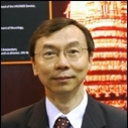Influence of the Envelope gp120 Phe 43 Cavity on HIV-1 Sensitivity to Antibody-Dependent Cell-Mediated Cytotoxicity Responses.
Raktažodžiai
Santrauka
HIV-1-infected cells presenting envelope glycoproteins (Env) in the CD4-bound conformation on their surface are preferentially targeted by antibody-dependent cellular-mediated cytotoxicity (ADCC). HIV-1 has evolved sophisticated mechanisms to avoid the exposure of Env ADCC epitopes by downregulating CD4 and by limiting the overall amount of Env on the cell surface. In HIV-1, substitution of large residues such as histidine or tryptophan for serine 375 (S375H/W) in the gp120 Phe 43 cavity, where Phe 43 of CD4 contacts gp120, results in the spontaneous sampling of an Env conformation closer to the CD4-bound state. While residue S375 is well conserved in the majority of group M HIV-1 isolates, CRF01_AE strains have a naturally occurring histidine at this position (H375). Interestingly, CRF01_AE is the predominant circulating strain in Thailand, where the RV144 trial took place. In this trial, which resulted in a modest degree of protection, ADCC responses were identified as being part of the correlate of protection. Here we investigate the influence of the Phe 43 cavity on ADCC responses. Filling this cavity with a histidine or tryptophan residue in Env with a natural serine residue at this position (S375H/W) increased the susceptibility of HIV-1-infected cells to ADCC. Conversely, the replacement of His 375 by a serine residue (H375S) within HIV-1 CRF01_AE decreased the efficiency of the ADCC response. Our results raise the intriguing possibility that the presence of His 375 in the circulating strain where the RV144 trial was held contributed to the observed vaccine efficacy.IMPORTANCE HIV-1-infected cells presenting Env in the CD4-bound conformation on their surface are preferentially targeted by ADCC mediated by HIV-positive (HIV+) sera. Here we show that the gp120 Phe 43 cavity modulates the propensity of Env to sample this conformation and therefore affects the susceptibility of infected cells to ADCC. CRF01_AE HIV-1 strains have an unusual Phe 43 cavity-filling His 375 residue, which increases the propensity of Env to sample the CD4-bound conformation, thereby increasing susceptibility to ADCC.



